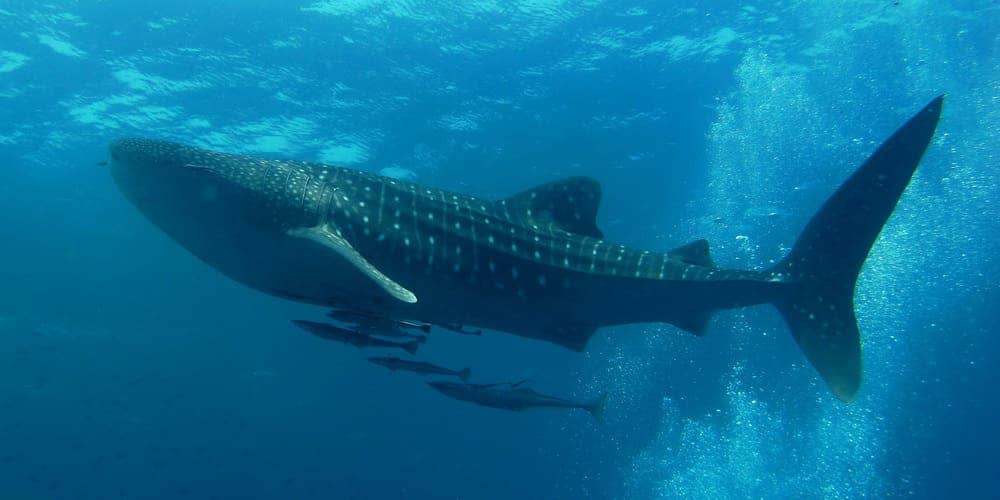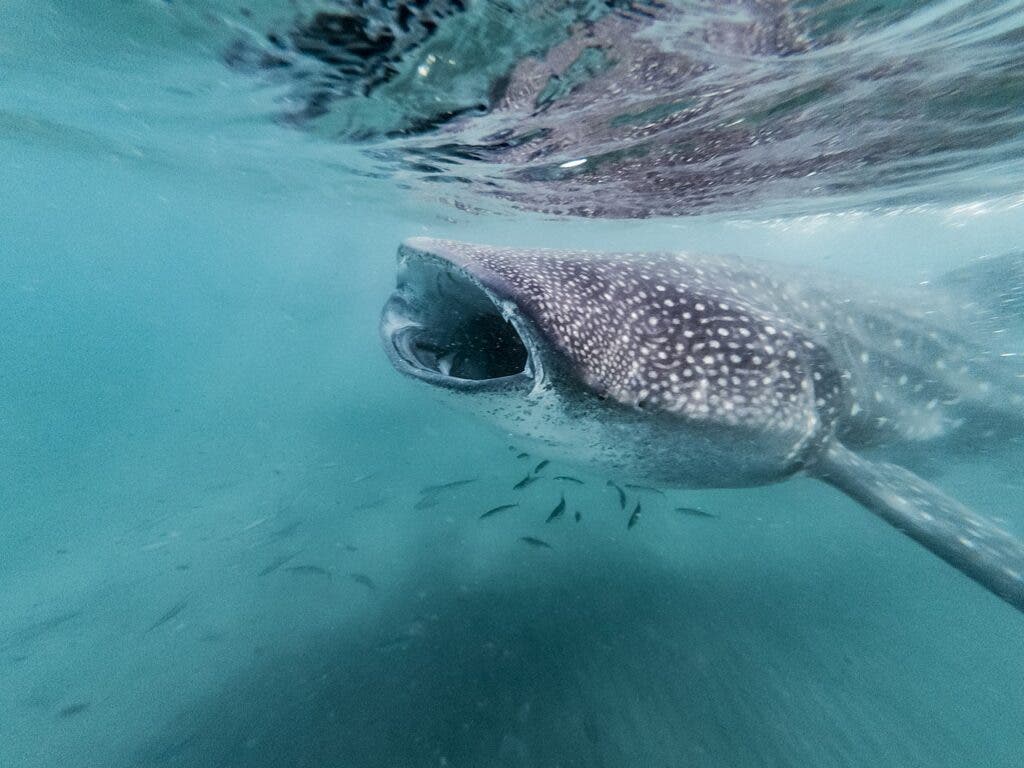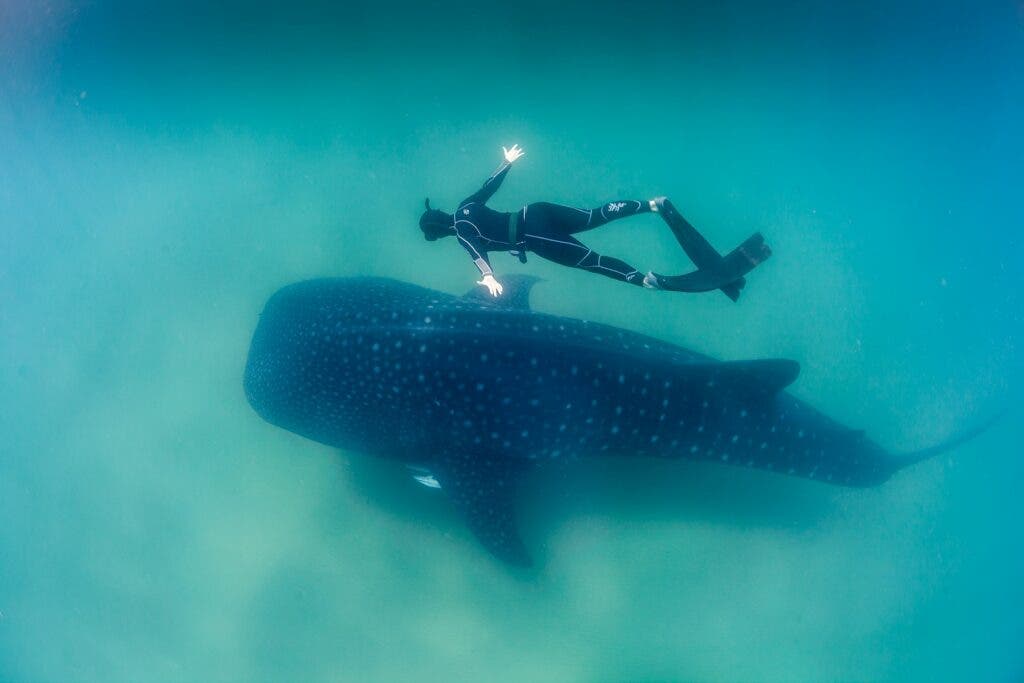The oceans are vast and full of surprises. You never know what lurks in the deep and shallow waters, from gracefully moving nudibranchs, the colorful, soft-bodied mollusks, to otherworldly looking fishes and even mammals. Among the many fascinating creatures in the ocean is a gentle giant, the huge but harmless whale shark — the largest living fish. But there’s more to this magnificent creature than meets the eye.

Whale sharks (Rhincodon typus) have somewhat confusing names. They’re not whales but technically sharks. They’re the biggest sharks currently alive, growing up to 65 feet (20 m) long (about the size of a bus) and weighing up to 20.6 tons.
This humongous fish is known to slowly roam around tropical seas, migrating every spring to breed and feed. These large sharks are very easy to distinguish and tell apart from other species as they look like spotted catfishes — except hundreds of times larger. It is impossible not to notice one if you come across it (either in the ocean or in a photo), but here are some of its defining physical characteristics to make sure what you’re looking at is indeed a whale shark.
How to identify a whale shark
This fish has a flattened head, a blunt snout above its mouth and small eyes. Whale sharks have a two-toned pattern of light spots against its dark gray back and have a white belly. Patterns of their spots make each individual unique as no two whale sharks possess the same pattern — they’re like fingerprints. They also have five large and noticeable gill slits, two dorsal fins, two long pectoral fins, two pelvic fins, one anal fin, and a large sweeping tail. But without a doubt, the most striking feature of a whale shark is its mouth.

The mouth of a whale shark is huge, measuring 4 feet (1.2 m) across. Despite its large mouth and body, the whale shark does not eat or attack humans or other larger creatures. Instead, these docile creatures are filter feeders and their meals are composed mostly of plankton, fish eggs, copepods, and coral spawn — though they won’t say no to small fishes and squids. When these sharks are hungry, they open wide and passively filter everything suspended in the water. It’s the same mechanism that baleen whales employ.
The whale shark still has many rows of teeth, but these are vestigial teeth that serve no role in feeding. Instead, feeding occurs either by ram filtration (the whale shark opens its mouth and just swims forward) or by active suction feeding (in which the animal opens and closes its mouth, sucking in water that is then expelled through its gills). Rather than using their teeth, the whale sharks use specialized flaps called velums that stop water from backflow when the shark closes its mouth, thereby preventing waste of food.
Planktonic diet
These formidable sized creatures are well adapted to this diet and have several physical adaptations that make them proficient at filtering. They can process more than 6,000 liters of water an hour thanks to their gills and additionally, the whale shark is equipped with 20 filtering pads that allow the animal to sift an average of 20.7 kilograms (45 pounds) of plankton in a day. They may eat small creatures but they make up for it with sheer numbers.

Whale sharks are slow-moving pelagic species, meaning they spend most of their time in the open ocean — and they’re not afraid of the deep sea. Studies have shown that they can reach depths of up to 6235 ft (1928 meters), although they prefer warm waters where there is a lot of plankton. Ironically, this largest shark has the smallest prey: it feeds off plankton, which it sweeps with its large, open mouth. In fact, whale sharks are so into plankton that they’re a good indicator for the presence of plankton, and in turn, this says a lot about the health of the oceans.
Threats and conservation

Along with many other sharks, whale sharks are in danger, both directly and indirectly. As climate change takes its toll, the waters become hotter and hotter and more unfriendly to oceanic species. In addition, expanding human activity means creatures like whale sharks have smaller habitats to work with, and are often accidentally (or intentionally) trapped in nets.
In Southern China and Oman, whale sharks are hunted in great numbers as their fin and oil are considered delicacies. Although they are considered vulnerable species, they are still continuously targeted in several parts of the world, especially eastern Asia. These activities alongside the impact of fisheries and ocean water pollution contributed to the steady decline of their population.
Whale sharks are dying faster than they can reproduce and their population has dropped by 65%, which has landed them in the Endangered category of the IUCN Red List and are in the Appendix II of CITES and CMS (Appendix II lists species that are not necessarily now threatened with extinction but that may become so unless trade is closely controlled). Simply put, whale sharks are in trouble, and their numbers continue to dwindle.
Through the years, whale sharks have become popular with snorkelers because of their size and tamed nature. Because of this, it has long been a tourist attraction to swim with them. Unfortunately, where there are humans, there is disturbance. Irresponsible tourism has been a threat to their population as in most cases they get injured by boat propellers. Additionally, since people want the sharks to be closer to their boat, they would hand feed them with shrimps and small fish thereby interrupting their natural feeding habit.
Conservation efforts by different organizations (WWF, Oceana, etc.) are now mobilized to help recover whale shark populations. In fact, every 30th of August, Whale Shark Day is being celebrated to shine a light on these graceful giants to heighten awareness and encourage participation for their conservation.
Whale sharks have relatively long lifespans. However, few whale sharks make it to adulthood, and the threats they face are numerous and diverse. Without serious and quick conservation action, their numbers will likely continue to dwindle.
This gentle giant is one of the most spectacular creatures in the ocean, and while it poses no threat to humans, humans pose a lot of threat to it. Hopefully, we can find ways to coexist with the whale sharks for many years to come.






